Text
Wednesday Lecture - Emily Speed
“My interests lies in the relationship between people and buildings and my work explores the body and its relationship to architecture. The idea of shelter and the inhabitant is at the core of much of my work; how a person is shaped by the buildings they have occupied and how a person occupies their own psychological space.” – Emily Speed
Whilst on a date in November, I unexpectedly saw Emily Speed’s Flatland exhibition at the Tate. I really enjoyed how she combined her soft and architectural cloth structures with the medium of performance film. Through focusing on the relationship between people and architecture, Speed has sparked an interest within me to delve into my own feelings for the buildings I’ve grown up in throughout my life, such as my childhood home, my schools and my grandparents’ house. It made me see the Tate building as a special place as I’ve shared experiences with different people there on multiple occasions, such as my parents, close friends and now potential lovers. My work primarily focuses on connecting with your inner child and memories, and I think it would be a good turning point in my practice to incorporate my feelings toward buildings and locations into that narrative.
0 notes
Text
Carousel Tutorials 5/11/21
Friday 5th November 2021
Over the last few weeks, I’ve been thinking quite in depth of my practice and where it’s leading me. I decided at the beginning of this semester that I would follow on from last semester’s theme of idol worship, however, taking a route centred on the veil of invincibility these idols wear. I had the initial idea of portraying them as God-like, mythical beings.
We’ve had a carousel of different tutors for the past three weeks and I’ve received a range of feedback on my work.
The first tutor, who I unfortunately can’t remember the name of, seemed unsure of my practice. She expressed that because my work mainly consists of portraits of famous figures, that it was infantile, lacking depth and obsessive. This frustrated me, as I’d explained that my work revolves around the relationships between people in power – or of a high status – and their loyal followers and is not simply glorified fan-art. For a long time, I’ve been interested in how these figures influence those that idolise them, despite their followers only knowing a public image rather than the real person behind it. It’s fascinating to me how close we can feel to our idols sometimes, so much so that parts of our personality and self-expression are borrowed from them, and they slowly become a part of us, just like the people we surround ourselves with every day. This discussion didn’t feel like a crit, but more like my work was being picked apart unfairly. It made me consider an alternate view: if I was male, would my work still be viewed as ‘obsessive’? Reduced to being labelled as ‘silly fan-art’, therefore having no depth? I understand that this is only one person’s perspective of my work, but it has been making me question what more I can do with my art to ensure that I’m communicating my ideas clearly to everyone who views it.
For the second week of the carousel, I had Roy, who was much more helpful in showing me different ways of expanding my practice. Roy pointed out that I seemed to already have a plan, which they said wasn’t necessarily a bad thing, but that it would be good for me to venture outside of the pathway I’d already set out for myself. I mentioned that I mostly focus on portraiture because I’m fixated on faces, but that sometimes I do find it tedious. Roy encouraged me to investigate portraiture more, by discovering how far one can push its boundaries. They explained that a portrait can take the form of readymade objects; we discussed Felix Gonzalez-Torres’ work ‘Untitled (Portrait of Ross in L.A.)’, where Ross, Gonzalez-Torres’ lover, was portrayed as a diminishing pile of sweets, symbolising his deteriorating health and weight loss after his AIDS diagnosis.

We also discussed the music video for ‘Don’t Touch My Hair’ by Solange, directed by Alan Ferguson and Solange herself.


The video contains shots mirroring artworks by artist Lynette Yiadom-Boakye, which show fictitious black figures in ordinary scenarios. The portraits are painted in a way that allows the viewer to see themselves in them, as all the situations are very mundane. Roy explained that the concept of creating a portrait of no one specific offers heavier relatability to its audience, as it requires no background context. I find this concept interesting as my portraits tend to be too specific to the subject. There’s nothing wrong with this, however, it could help my practice to be understood more if the subject was a little vaguer.
This week I spoke to my normal tutor Rick, who out of the three tutors I’ve seen has the most background knowledge of my practice and its progression. We concluded that the initial idea mentioned above of idol worship was a little too ambitious as it isn’t broad enough. I explained that despite this I’m still very interested in fairy tales and children’s stories and wanted to include them in my artwork somehow, and Rick wanted me to dig deeper and find out why this is. To discover why I feel an almost gravitational pull towards child-like themes. I’ve felt quite lost with my artwork this year as I’ve had many new ideas but struggled to communicate them properly, or even to just put them to paper at all. Getting back into creating things again has been difficult, and I think the one thing making it worse is feeling as though I must know where my practice is leading, and what each complete piece should look like. I have many concepts in mind that I want to try but trying to make sense of them and link them all together has become stressful, so I’m taking a step back to reassess it all. I came to the realisation last year that my practice always leads back to the theme of childhood one way or another, so it seems to be more natural to investigate that pathway more. I’ve learned that my artwork is an extension of myself, and so I should start with ideas that I’m most familiar with first before I venture elsewhere.
1 note
·
View note
Text
Jean-Michel Basquiat: Rage to Riches
Basquiat is a name I have known for what seems like my entire life. However, I only became acquainted with the artist and his work when watching this documentary.
His work held a very anatomical theme, which appears to have been largely influenced by the copy of Gray’s Anatomy he received as a get-well-soon present after being hit by a car as a young child. Towards the end of Basquiat’s life his artwork became more representative of his mortality and the fears that come with being a black man. He was traumatised by the death of Michael Stewart, a fellow artist friend of his that also grew up in New York. Stewart was African-American and was murdered by the police. Just over a year prior to his own death, Basquiat’s dear friend Andy Warhol suddenly passed away after gallbladder surgery. In addition to this, both the AIDS epidemic and the heroin crisis were worsening across the USA, making mortality a looming thought in Basquiat’s mind, and consequently a prevalent theme in his artwork.
Although my own practice is quite different from Basquiat’s in all aspects, I’ve truly grown to admire his work. It’s very personal to him and reflects his experiences of being a black male in America, and as the mainstream art world is very white dominated, it’s refreshing to be offered a new perspective.
0 notes
Text
Phyllida Barlow
Phyllida Barlow is an English artist that is largely inspired by how things fail. Her practice centres on unconventional sculptures made to look as though they could collapse at any given moment. Barlow uses materials such as wood, plaster and chicken wire. Her pieces stir mild anxiety within me due to how unstable they look, but for Barlow, there’s a comedic element to this. Her sculptures are made to create unease within spectators but are in fact also made to be structurally sound. The scale of her works are so large that both the size and the uncertainty of them caving in makes the viewer feel insignificant and vulnerable. For me, Barlow’s artwork is a way of allowing her audience to question why we as a society are afraid of failure, when in reality, it is an inevitable part of life that we must come to terms with.
In addition to being a part-time artist she is also a mother and a primary school teacher, which could very well explain her childlike selection of colours — Barlow primarily uses vibrant shades of the primary colours in her sculptures. I like this as I have personally always preferred a warmer palette and my own practice focuses on elements of childhood.
0 notes
Text
MA Artists (1)
For this lecture we were introduced to 4 artists who are currently enrolled onto LJMU’s Fine Art MA, whose practices all revolved around performance art. Two in particular stood out to me:
Cos Ahmet
Ahmet told us that he pursued the MA in order to rethink his practice, and the work he presented to us was themed on his perceptions of the human body. He used constructive materials such as pieces of carpet, domestic pipes and plaster in order to ‘rethink’ the body, and how it can be manipulated to be used in any way we like. Ahmet’s work gradually started to take a more performative approach and he began to use more delicate materials, such as cello tape, to emulate the shedding of human skin. I love the tenderness of Ahmet’s practice as to me it demonstrates him questioning his identity as a living being and what the body is capable of. I think that this is a very fitting theme to follow in the current pandemic as many of us have been forced to understand ourselves better over the past year.
Abbie Bradshaw
Bradshaw is primarily a performance artist and her work is thematically very sensory. She focuses on touch and sound and what she feels when she experiences these things. Bradshaw uses objects to ‘find a new language or connection with the space that [she exists] in’. A performance of hers that particularly stuck with me was This is how I sound, in which Bradshaw is covered completely in a blanket and traces a microphone connected to an amp all around her body, to create an auditory experience. I personally view it as having feminist connotations, as women are almost always sexualised in the media for how they look, and Bradshaw challenges that by forcing the spectator to think beyond that and potentially create their own image of her in their minds.
0 notes
Text
David Blandy
David Blandy is an English artist that deals with themes of identity and escapism. His work is quite unconventional compared to our previous Wednesday lecturers in that his main body of work consists of the role play games he has been working on for the past few years, Babel and World After, respectively. He is largely inspired by sci-fi films such as the Alien franchise, anime and manga. He is driven by the idea of using these forms of media to escape from reality, in order to create a space to ‘rethink’ society — a way of seeing the world afresh. Blandy briefly mentioned that his grandfather was interred as a prisoner of war in Japan, and has made artwork demonstrating this conflicting relationship that he has with the country. Japan’s glamorous attempt to cover up its grim history with anime culture is, in itself, escapism.
Despite myself having a small knowledge of role play and video games, I found Blandy’s relationship with them very charming. I myself as a neurodivergent person have found my own forms of escapism through books, movies and even celebrities. It sometimes feels as though the world doesn’t move to my speed, and since it’s so media-controlled these days it feels almost euphoric to get lost in a different one. One where we can reimagine ourselves and find new ways of questioning authority and take a new view of the world. And as we find ourselves still in the midst of a global pandemic, escapism is more important than ever. I feel like it can help to develop a better sense of self, something a lot of us have been struggling to come to terms with.
0 notes
Text
The Male Gaze in Art
In one of our previous Tuesday lectures we studied Parisian art, and a very prominent running theme was the male gaze. I had heard of the term previously in feminist media but I don‘t think I fully understood what it meant until this lecture, and I had certainly never considered it to be a concept featured in traditional art, which I understand was quite naive of me. It was explained to us that male painters would very often paint portraits of naked women, and this was not simply to appreciate the female form, but rather to objectify women and portray them as only existing for the pleasure of men. However, a naked woman in a painting isn’t always objectification - it is distinguishable whether or not this is the case by how the model is posed, or by the context. For example, we were shown two paintings:


The first is a nude by Modigliani, and the second by Manet. In the Modigliani piece, it is a clearly a piece made for the satisfaction of men due to the way the model is posed. Her arms are resting up by her head to focus the attention on her body rather than her face, and her body is stretched out seductively with an arched back. The Manet on the other hand makes the viewer question whether they should be looking at the scene at all. It depicts a nude woman having lunch with two male academics, however, in this piece, the woman is making eye contact with the viewer, as if to say ‘and what are you looking at?’. Manet’s artwork actually challenges the male gaze and instead of sexualising the female body, it normalises it. Yes, the lady is naked. And what about it? She’s having lunch with what looks like her friends and you’re being rude for staring.

We were also shown an artwork by Mary Cassatt. In the painting there’s a wealthy woman sat in a balcony at the opera. Whilst she appears to be watching the stage, there is a man staring at her in a scrutinising way from across the other side of the theatre. It demonstrates that even when women are minding their own business they will forever fall under the scrutiny of men.
2 notes
·
View notes
Text
Inner Child pt. 2
For my 4D project, I decided to make artwork out of ‘Inner Child’. I felt that the theme of reflecting on my younger self that the song discusses was a clever way of incorporating time into my work. I was also very inspired by Rembrandt’s work that I talked about in one of my earlier posts. The very intimate relationship relationship he had with himself was something that I really wanted to bring to my work, so I decided that I would turn this portrait in to a series.
With these two ideas in mind, I decided to put them together and create a ‘layered portrait’.

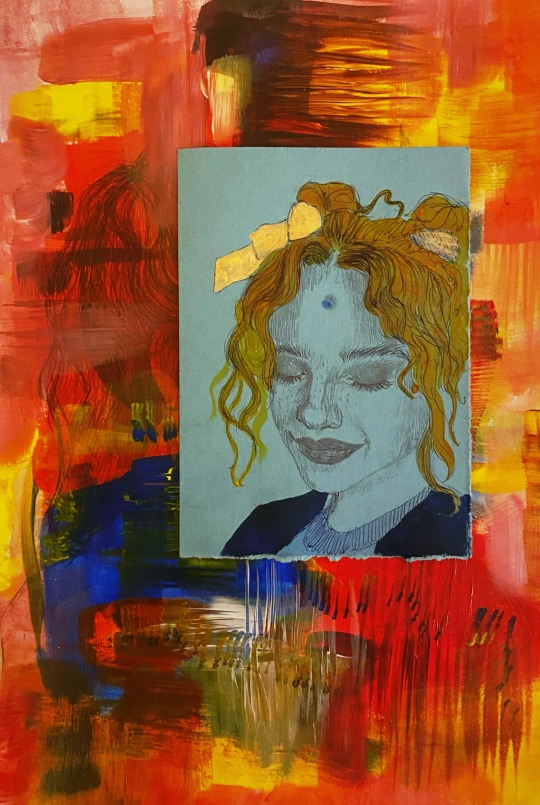
I began with the portrait of myself when I was 14 years old, and then after painting over it, I added a smaller, more current, portrait of myself. Rather than copying Rembrandt entirely and creating a series of portraits, I have decided that as the years go on I plan on layering up portrait after portrait. This is my way of explaining that, even as I get older and mature, there will always be the scared inner child within me underneath all my other layers and versions of myself.
I also created an additional developed piece out of the first portrait:

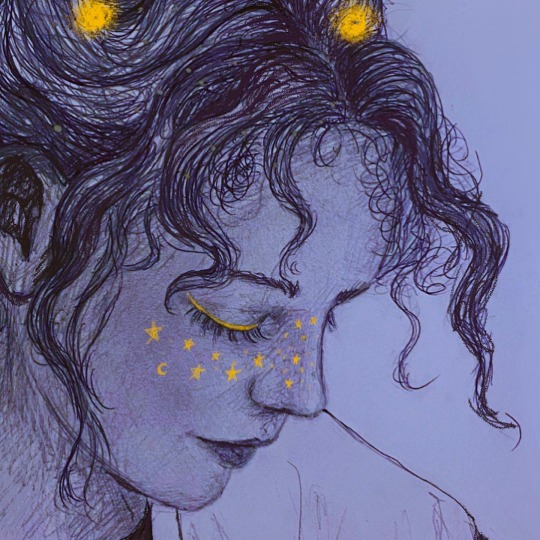
0 notes
Text
Artemisia Gentileschi
A few weeks ago we were assigned documentaries to watch as opposed to attending lectures. One of them was about the life of Italian artist Artemisia Gentileschi, who I had heard of in the past but had never closely studied before.
She was taught the basics of painting by her father Orazio who was also a painter, but was also a talented painter in her own right. Artemisia was tragically raped by her art teacher, but eventually turned out to be the first woman to ever win a rape trial.
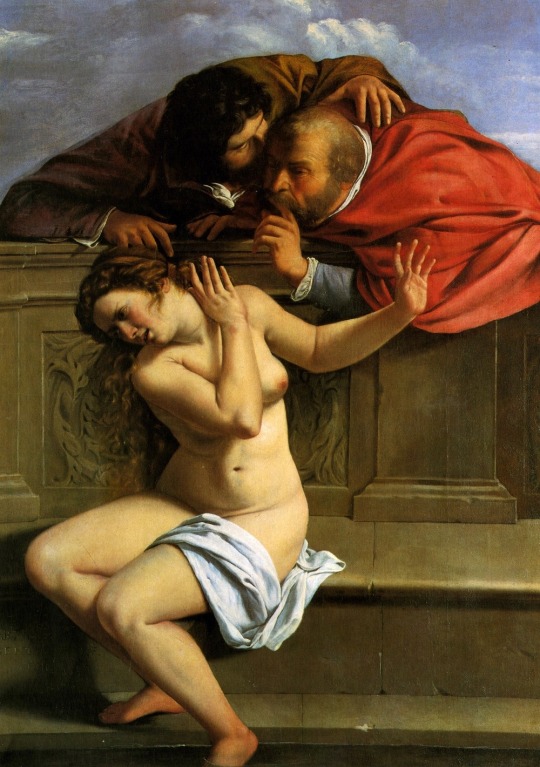

Many male painters of her generation focused their painting on the male gaze, showcasing nude women in a vulnerable manner that is only pleasurable for male audiences. Artemisia on the other hand, was one of the leading women that challenged this and brought to light the female gaze. Instead of focusing her paintings on what she believed to be attractive to men, she instead made the perspectives of women in society her main focal point. Many of her paintings depicted men harassing and preying on young women, and almost as a response to her own work, her later paintings showed women grotesquely murdering men that have wronged them. Her most famous of these, ‘Judith Beheading Holofernes’, was painted after she was raped by Agostino Tassi.

Since watching the documentary I’ve realised that I’m fascinated by women in the arts. Artemisia has made me realise that I’m not acquainted with enough women artists. Shockingly, I only recently discovered Tracey Emin. I also don’t listen to enough women singers and I’ve barely seen any films made by women creatives. Art made by men can be so beautiful; I will forever be fascinated by the works of Michaelangelo. But, for me, artworks by women are so much more personal and resonate with me on a much deeper level. Women feel and process feelings and events much differently to men and the female gaze is not well documented in pre-Raphaelite works, which is why I’ve taken such a liking to Artemisia.
4 notes
·
View notes
Text
Inner Child pt. 1
I really love a song called Inner Child by the South Korean group BTS; the song is from the point of view of a modern day Kim Taehyung (the songwriter) speaking to his younger self. This verse in particular really sticks out to me:

He talks about how insecure he was as a teenage boy, how he wasn’t sure if he was ever going to be good enough or if he would ever be able to achieve his dream of becoming a singer. As an adult he is able to confirm to his younger self that everything will be okay, but a sort of pain can be felt when he says this because we know he cannot physically go back in time and comfort the younger Taehyung. This really resonates with me because I too often think about the inner turmoil I experienced as a young teenager. I wish I could’ve had someone to comfort me and tell me that I hadn’t lived yet. That I had so much to look forward to and that one day I would love myself and finally experience true happiness.
Despite my personal growth, that scared child still lives in me today. But I will always be proud of how I persevered and pushed through because I was determined to love myself.
I really wanted to incorporate this element of childhood into my work because it’s such a personal topic, and, for me, if I can’t put my personal feelings into my artwork, then it’s meaningless. Creating is an outlet for me to vent out my emotions, whether it’s extreme sadness or intense happiness. I’ve realised that this has always been prevalent in my art; I’ve realised that I can’t just make pretty things for the sake of having something pretty. But wow, I admire people that do.
0 notes
Text
4D Project
To start off our new Dimensions period, we were introduced to our 4D Project with a short film by Rory. It introduced us to a wide variety of media that we could experiment with in our our work, ranging from live performances, portraiture through time, to unscripted films. All of these linking together with the theme of time. A few stood out to me, both good and terrible:
Rembrandt -- Self Portraits
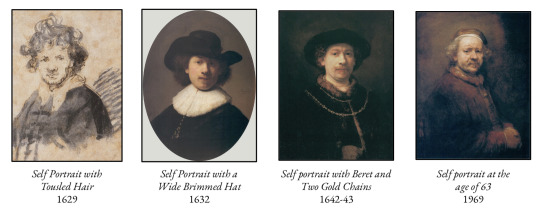
Rembrandt’s self portraits were some of the first pieces I saw in the film and I couldn’t help but fall in love with them. They’re a beautiful documentation of how his artistic style developed over his lifetime, and I can’t help to feel a kind of sentimentality emitting from them. As he got older, you can clearly see that he put a lot of care into expressing every minute detail. For me, they showcase the intimate relationship that Rembrandt had with himself and I find that very endearing.
Rauchenburg -- ‘Untitled White Canvas’

The first time I ever saw this kind of art concept (you know the kind - where artists do the absolute bare minimum and call it ‘art’) I found it quite moving. It provoked the question ‘what actually is art?’ which I think is a very important question to ask yourself every once in a while. Art doesn’t always have to have a deep meaning, you can just appreciate it for what it is a lot of the time. However, this many years ago when I was first investigating artists in high school. Since then, I have seen this concept. So. Many. Times. It’s exhausting. Frustrating. Dare I say, pretentious. I feel the same way about the banana that Maurizio Cattelan duct-taped to the wall. Sometimes I just want to see some nice paintings that people have put days of their time into, you know?
Anya Gallaccio -- ‘Preserve Beauty’
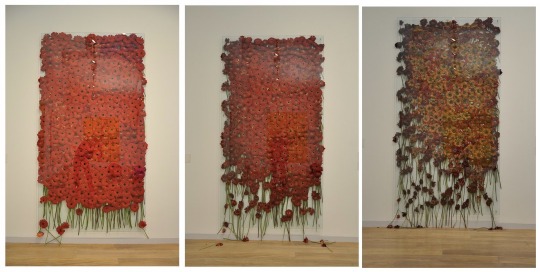
I really felt a fondness for this when I first saw it. To me it serves as a reminder that not everything lasts forever and that we must learn to enjoy things in the moment. I recently lost someone very close to me due to cancer, so this message really hits home. There’s a real beauty in using something as simple as flowers. This piece would’ve required a lot of pre-planning and would’ve most likely only been prepared the day before the exhibition, so I admire Gallaccio’s commitment.
Marina Abramovic & Ulay -- Gallery Door Performance

In case it isn’t clear from the title or the images, this is an audience-participation live performance. It involved two naked individuals standing in the doorway to the exhibition. In order to enter the exhibition, audience members would’ve had to press their bodies against the two individuals. I have a very big issue with this piece, but before I talk about it, I must declare that I understand that the performance is based around the idea of challenging your personal boundaries and encouraging you to overcome them or push them further. However, this piece was orchestrated in the 1970s where societal standards were a lot different to today. This performance would not fly if it were to reappear today. My big issue with it is that it brings up the idea of consent. I have no issue with nudity, but if I had planned a day to go to an art exhibition to only find that I can’t see any of the artwork unless I have strangers’ genitals rubbing against my body, I would be sorely disappointed. I’d feel violated. What if someone was a sexual assault survivor and they were faced with that? I really wonder what was going through these people’s minds.
0 notes
Text
Mini Degree Final Project
For my final project to wrap up the mini degree, I was initially stuck for ideas. We were told that we could develop ideas that we had explored in the previous two weeks, and out of those I was most invested in the work that I had done in Week 1: the crown. I really enjoyed exploring the idea of sovereignty, and after talking about my work with Rory and him linking it with both the innocence and ignorance of childhood with the way I had made my crown, I was adament to entertain this idea more.

Although I had already made a ‘dress up’ crown and wasn’t sure on how to go further with this, this obstacle was quickly solved after watching a few episodes of The Crown. In this particular episode, Queen Elizabeth (Claire Foy) is wearing a royal cloak/cape, as monarchs do during coronations and other key events. I decided to stick with the cloak idea, but I still dwelled on how I was going to make it.

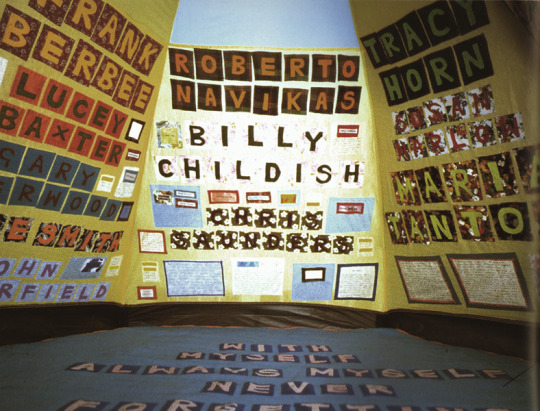
The next day I had a History of Art lecture and Juliet introduced me to Tracey Emin. That name has been familiar with me since high school, but until this lecture I had never actually seen her work. I feel in love instantly. I love her textile work the most, and I was particularly taken by one of her most famous pieces Everyone I Have Ever Slept With 1963-1995, also aptly titled ‘The Tent’. I adored the applique style of the lettering and how warm it made the piece feel. This inspired me to add a quote or a phrase onto my cloak, and from here I thought that it would be meaningful to use a blanket that I had made over the COVID lockdown to use as the cloak itself. I thought that, if I were to maintain the childlike feel that I created with the crown, that an already existing and already used blanket made perfect sense as that is what children commonly us when they dress up as kings, queens and superheroes. For the lettering, I believe it would have looked aesthetically attractive if I had used the same applique technique that Tracey Emin did, but I only had 4 days to complete the piece and source materials, which I figured to be impossible. So, as an alternative I used card and wrote big letters on them - in a font that mimics alphabet fridge magnets to, again, maintain that childlike feel - and decorated them with gold paint and star stickers.
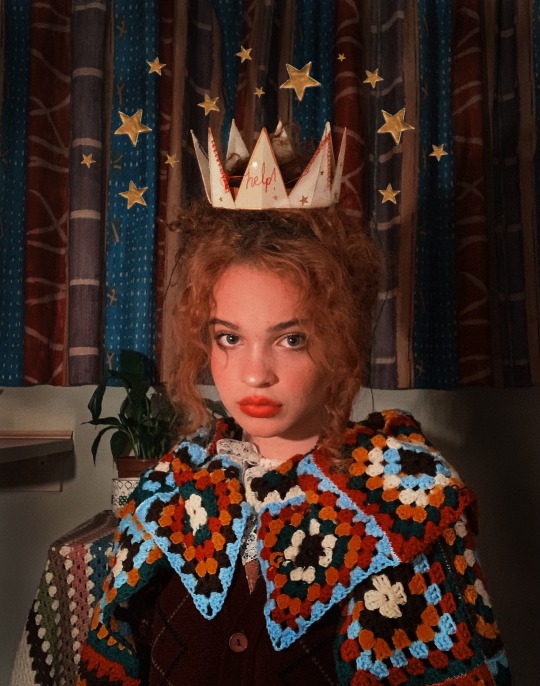

I thought long and hard about what I wanted the cloak to say, but eventually I found that I had been overthinking it. And so, I settled on the very simple phrase ‘I am my own’. It didn’t have to be overtly insightful, it just had to be to the point.
0 notes
Text
Matter and Anti-Matter
For my project I was paired up with Ruby, and I drew my inspiration from her work. On her piece of paper, she had a written a large number of keywords: three of them, ‘help’, ‘hostage’ and ‘confidence’ stood out to me.
Having a nude model appear on my computer screen for my first art session of my degree took me by surprise, but this surprise quickly turned into admiration for the model, because I knew I could never have the confidence to pose nude myself.
This got me thinking about the stigma surrounding women’s nudity, which brought to mind the well known phrase ‘my body is a temple’, which I believe can be interpreted in two ways:
One way is the more feminist stance that women have full control of their bodies, that they are the ‘God’ that the ‘temple’ was built for. As a result, I chose for my work to take the form of a handmade crown: to resemble self-established power.
Alternatively, the phrase can be read as a more patriarchal viewpoint: that women’s naked bodies should be gatekept and reserved only for their male partner’s eyes. Following with the theme of the crown and royalty, a King’s queen was historically maried into the family for reproductional reasons, and to essentially become an object - in this scenario the queen holds no power. And because it’s taboo for royals to separate, the queen is bound to that life forever. A ‘hostage’, if you will. This is what led me to embroider Ruby’s words ‘help!’ and hostage’ on the crown, as it is no longer a symbol of liberation, but the shackles of a life of objectification.
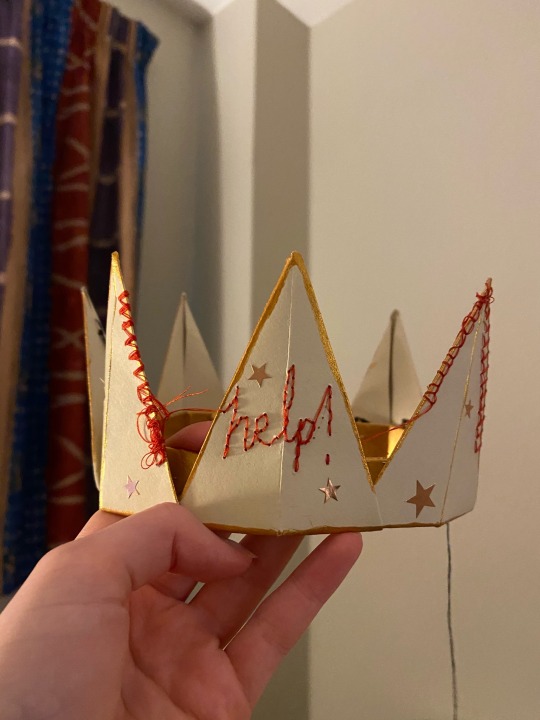
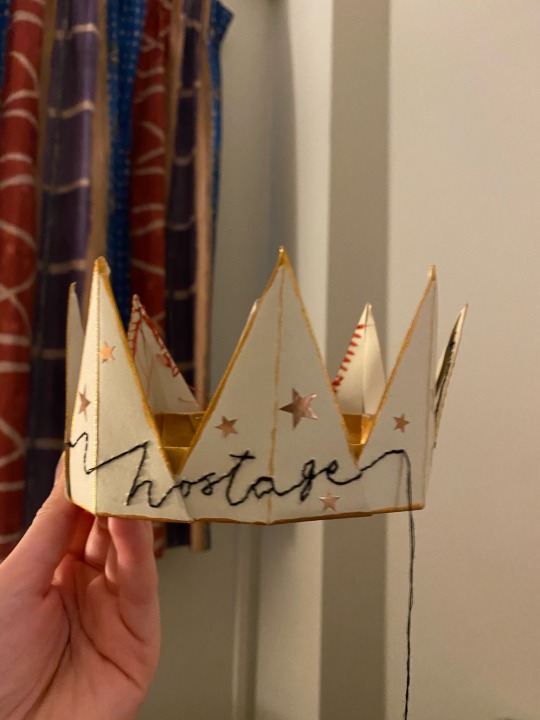
1 note
·
View note